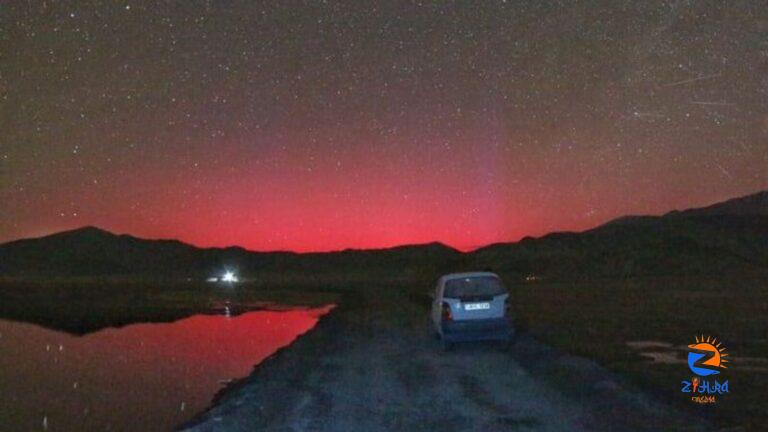
[ad_1]
The aurora borealis is usually visible in high-latitude regions around the Arctic and Antarctic. It is caused by disturbances in the magnetosphere, mostly triggered by the solar wind.
However, it was visible for the first time in Indian skies. The Indian Astronomical Observatory, for the first time, captured the aurora borealis on camera in Ladakh’s Hanle above Mount Saraswati.
Also known as the Northern Lights, the aurora borealis was visible from Ladakh at 34-36°N, an incredibly rare sight at such low latitudes.
According to reports, the auroral red arc emerged in Ladakh’s Hanle region on May 11 at around 1 a.m. The phenomenon is expected to continue through the weekend in Ladakh as additional coronal mass ejections enter Earth’s outer atmosphere.
As per the US National Oceanic and Atmospheric Administration (NOAA) Space Weather Prediction Center, the occurrence of a severe (G4) Geomagnetic storm, classified as G4 on NOAA’s scale, took place in Ladakh despite it being located at mid-latitudes.
ALSO READ: Northern lights dazzle over UK, Europe, skywatchers say, ‘Get a load of this aurora borealis’
This aurora was earlier visible in Ladakh during the night of April 22-23, 2023, which experts cite as a result of a coronal mass ejection on April 21. This ejection triggered a G-4 class geomagnetic storm on Earth.
Apart from Ladakh, the aurora borealis were also visible across parts of Europe and China. The arcs formed were not like traditional auroras that display a variety of colours in dynamic patterns, but they had a a fixed colour and it was reddish.
Explaining the phenomenon, Scientific Officer of Institute for Plasma Research Centre Dr Ravi A V Kumar said, as quoted by news agency ANI, “Solar Flares are very common, it happens all the time…It happens when the sun gets to the peak of its activity of 11-year circle…After every 11 years, the activity of the sun goes from high to low and in 2025 the activity is going to be at its peak…The chance of solar flares coming out at this time are more…These are highly charged particles of plasma which can travel at very high velocities… The faster these particles move the more dangerous they are…Since these are charged particles from the sun they can get deflected from Earth’s magnetic field…”
“Some of these deflected particles can come to polar regions of the earth which then interact with gas molecules in the upper atmosphere and they produce a colour called Aurora…When there is a very strong solar flare like the one which happened yesterday when combined with the Earth’s atmosphere and magnetic field produces Auroras..People are very fortunate to even see this right upto Northern Italy…The Aurora could also be seen in Hanle Ladakh…” he added.
“Flares come and go, they don’t affect us directly but can affect our day-to-day activities like communication as the satellites can be disrupted…Satellite TV signals and radio communication could also get disrupted…” Kumar said.
Where else the aurora was seen:
Russia, Australia, Germany and Tasmania also witnessed the rare phenomenon. In Russia, the aurora borealis was seen illuminating the night skies, while the aurora borealis was visible in the northern regions of Germany. Similarly, in Australia’s southern region Tasmania, people were seen capture stunning images of the aurora australis.
Unlock a world of Benefits! From insightful newsletters to real-time stock tracking, breaking news and a personalized newsfeed – it’s all here, just a click away! Login Now!
Download The Mint News App to get Daily Market Updates.
Published: 11 May 2024, 07:03 PM IST
[ad_2]